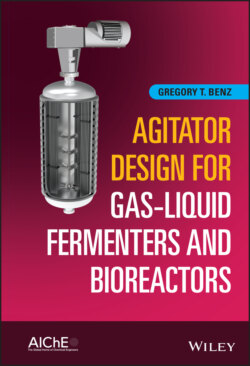Читать книгу Agitator Design for Gas-Liquid Fermenters and Bioreactors - Gregory T. Benz - Страница 76
Holdup
ОглавлениеWhen gas is dispersed into liquids, it does not rise to the surface instantly. Smaller bubbles take longer to discharge at the surface than larger ones. High power/volume produces smaller bubbles, on average. And the more gas is introduced, the more that will be present in the broth at any given moment. Moreover, as the agitation gets stronger, there is more recirculation of bubbles. All of these things contribute to gas holdup.
From a fluid property point of view, surface tension, ionic strength, presence of solids, presence of a second liquid phase, and viscosity all influence holdup. Holdup may be defined as:
(4.2)
For a water‐like fluid, the holdup may be estimated as follows, using the MKS system of units:
(4.3)
The effect of viscosity can be very complex. Sensel et al. [2] suggested the following:
(4.4)
These equations are approximately valid for holdup fractions of up to 20%, yet some fermenters run at over 40% holdup. Viscosity was tested through 350 cP, but many fermenters operate at a higher viscosity than that. Also, the above equation cannot be used for mixed impeller types and diameters. For best results, an empirically derived holdup expression should be developed for the specific broth in question.
